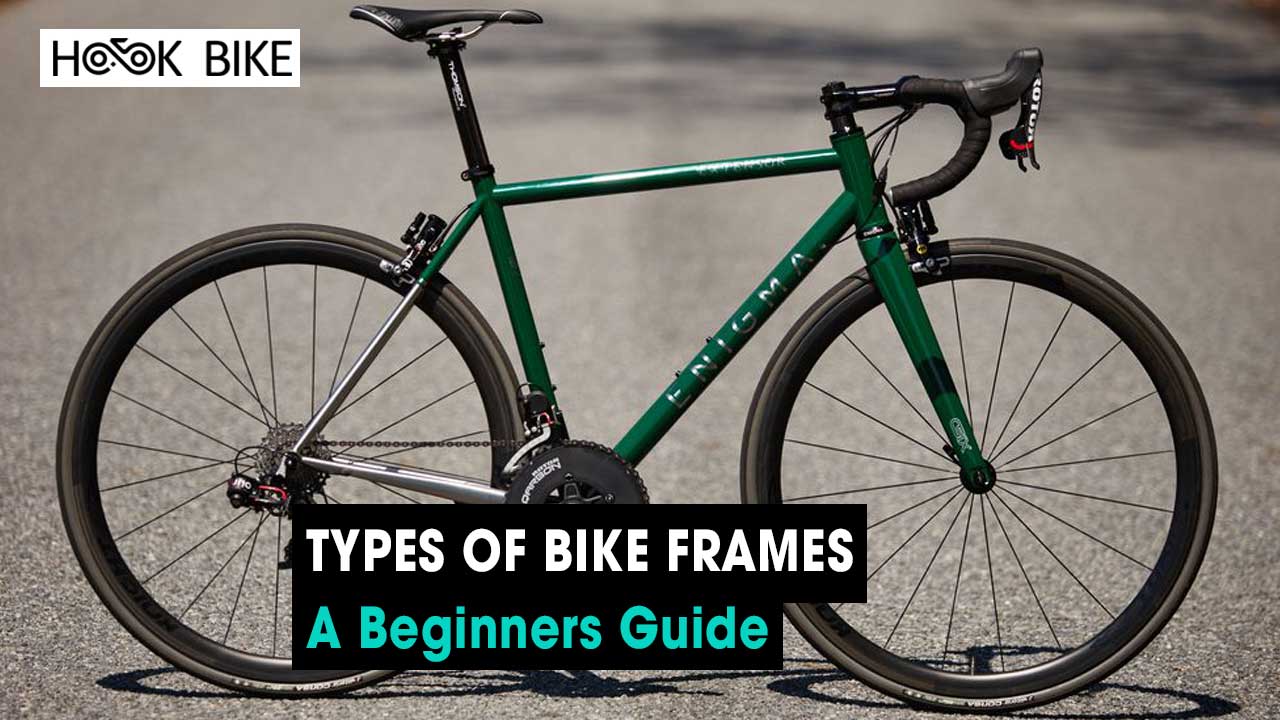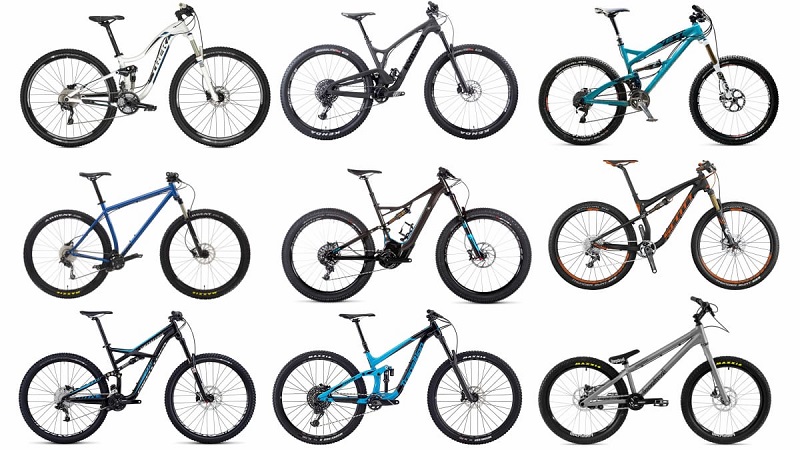Parts
Types of Bike Frames – A Beginners Guide
Cycling, an age-old pastime and a mode of transport for many, has seen a surge in popularity over the years. At the heart of every bicycle lies its frame. The choice of bike frame not only determines the bicycle’s aesthetic appeal but also its performance, functionality, and comfort. In this comprehensive guide, HookBike’s will explore the various Types of bike frames, diving deep into their features, benefits, and suitable applications.
Types of Bike Frames – A Beginners Guide
Before delving into the specific types, it’s crucial to understand the fundamental components of a bike frame. The main parts include the head tube, top tube, down tube, seat tube, seat stay, and chain stay. These components collectively determine the frame’s geometry, which in turn affects how the bike handles, its stability, and the rider’s posture.

Road Bike Frames
- Characteristics: Sleek, lightweight, and designed for speed.
- Material: Often made from aluminum, carbon fiber, or titanium.
- Best For: Long-distance cycling on paved roads.
- Road bikes are known for their agility and speed. The frames are built to be aerodynamic, reducing air resistance and enabling the rider to maintain high speeds over long distances.
Mountain Bike Frames
- Characteristics: Robust, with suspension systems to handle rough terrains.
- Material: Typically constructed from aluminum or carbon fiber.
- Best For: Off-road trails, rocky terrains, and rugged paths.
- Mountain bike frames are designed to withstand the challenges of off-road cycling, with features that absorb shocks from bumpy trails.
Hybrid Bike Frames
- Characteristics: A blend of road and mountain bike features.
- Material: Commonly made of steel or aluminum.
- Best For: Urban commuting, casual rides, and light off-road trails.
- Hybrid bikes offer the best of both worlds. They combine the sturdiness of mountain bikes with the speed and agility of road bikes, making them versatile options for varied terrains.
Touring Bike Frames
- Characteristics: Strong, with mounts for carrying bags and gear.
- Material: Usually constructed from steel.
- Best For: Long-distance travels and expeditions.
- Touring bike frames prioritize comfort for prolonged rides and have features to accommodate heavy loads, making them ideal for adventures and long journeys.
BMX Bike Frames
- Characteristics: Compact, sturdy, with a straightforward design.
- Material: Typically made of steel or aluminum.
- Best For: Tricks, stunts, and short-distance rides.
- BMX bike frames are built for agility and durability, catering to riders who engage in freestyle tricks and jumps.
Time-Trial and Triathlon Bike Frames
- Characteristics: Ultra-aerodynamic, with a forward-leaning geometry.
- Material: Commonly made from carbon fiber.
- Best For: Competitive racing against the clock.
- Specifically designed for racing, these frames minimize air resistance, allowing riders to achieve their fastest times.
Gravel Bike Frames
- Characteristics: Versatile, with wider tire clearance.
- Material: Often made from aluminum, carbon fiber, or steel.
- Best For: Mixed terrains including roads, dirt paths, and gravel.
- Gravel bikes are the adventurers of the cycling world, capable of handling various terrains without compromising on speed or comfort.
Fat Bike Frames
- Characteristics: Broad and robust, designed to accommodate wide tires.
- Material: Primarily constructed from aluminum.
- Best For: Snow, sand, and other soft terrains.
- The unique design of fat bike frames, with their expansive tire clearance, allows them to traverse terrains that other bikes would find challenging.
See more: what are bike frame sizes?

How much do bicycle frames cost?
The cost of a bicycle frame can vary widely based on factors such as material, brand, type of bike, manufacturing process, and special features. Here’s a general range for various types and qualities of frames as of my last update in January 2022:
Aluminum Frames
- Entry-Level: $100 – $400
- Mid-Range: $400 – $1,000
- High-End: $1,000 – $2,500
Steel Frames
- Entry-Level: $150 – $500
- Mid-Range: $500 – $1,500
- High-End: $1,500 – $3,500 (This includes boutique, custom-made frames.)
Carbon Fiber Frames
- Entry-Level: $500 – $1,500
- Mid-Range: $1,500 – $3,500
- High-End: $3,500 – $10,000+ (Top-tier racing frames or custom carbon frames can be very pricey.)
Titanium Frames
- Mid-Range: $1,500 – $3,000
- High-End: $3,000 – $7,000 (Like steel, custom-made titanium frames can be on the higher end of this range.)
BMX Frames
- Entry-Level: $50 – $200
- Mid-Range: $200 – $500
- High-End: $500 – $1,000+
Mountain Bike Frames
- Entry-Level (Aluminum): $100 – $500
- Mid-Range (Aluminum or basic Carbon): $500 – $2,000
- High-End (Carbon): $2,000 – $5,000+
Track/Fixed Gear Frames
- Entry-Level: $100 – $400
- Mid-Range: $400 – $1,000
- High-End: $1,000 – $2,500
These prices are ballpark estimates and may vary based on brand, region, availability, and new technological advancements. It’s also worth noting that sometimes buying a complete bike can offer better value than buying a frame and components separately.
If you’re considering buying a new frame or bike, it’s always a good idea to check with local bike shops, online retailers, and manufacturer websites to get the most current pricing.

Choosing the Right Bike Frame for You
Choosing the right bike frame is crucial for comfort, efficiency, and safety. Here’s a guide to help you pick the right frame size and type:
Type of Riding
- Road Biking: Lightweight frames designed for speed on smooth roads. They usually have a more aggressive geometry.
- Mountain Biking: Sturdier frames built to withstand the demands of off-road trails. They come in different styles like cross-country, trail, enduro, and downhill.
- Commuting: Frames designed for everyday use, often featuring mounts for racks and fenders.
- Touring: Built for long distances and carrying loads. These frames are robust and have multiple attachment points for panniers.
- Hybrid/City Bikes: A versatile option suitable for city rides and light trails.
- BMX: Compact frames made for tricks and short, fast races.
Frame Material
- Aluminum: Lightweight, stiff, and affordable. Most common in modern bikes.
- Steel: Heavier but offers a smooth ride due to its natural damping properties. Durable and can be repaired easily.
- Carbon Fiber: Very lightweight and can be molded into aerodynamic shapes. Offers good vibration damping but can be expensive.
- Titanium: Combines the best qualities of aluminum and steel. Lightweight, strong, and has a smooth ride feel.
See more: Bike Frame Size Chart

Frame Size
- Standover Height: When straddling the bike, there should be a gap between you and the top tube. This gap can range from 1-3 inches based on preference and type of riding.
- Seat Tube Length: Determines the saddle height. Ensure it allows for proper leg extension.
- Top Tube Length (or Effective Top Tube): Important for reach. Ensure your arms and torso are comfortable when holding the handlebars.
- Consult a Size Chart: Most manufacturers have a size chart based on your height.
Frame Geometry
- Aggressive Geometry: Usually found in racing bikes. The rider is positioned more aerodynamically but might not be as comfortable for some.
- Relaxed Geometry: More upright position, offering more comfort, especially for long rides or commuting.
- Wheelbase: Longer wheelbase offers stability, while a shorter wheelbase makes the bike more agile.
Test Ride
Always try before you buy. A bike might look perfect on paper, but it’s essential to feel how it rides. This will also help you determine if any adjustments or different components are needed.
Custom Frames: If you have unique requirements or want a perfect fit, consider getting a frame custom-built for you. It’s more expensive but ensures the bike is tailored for your needs.
Future Adjustments
Remember that while the frame is foundational, many components (like the stem, handlebars, and saddle) can be changed to fine-tune your fit.

Budget
Set a budget and try to stick to it, but remember that a good quality frame can last for years, so it might be worth investing a bit more.
When in doubt, consult a local bike shop or a bike fitting specialist. They can provide invaluable advice tailored to your specific needs.
Conclusion
Bike frames are the backbone of any bicycle, determining its functionality, comfort, and performance. As we’ve explored in this guide, various types cater to different riding needs and terrains. From the sleek road bike frames designed for speed to the rugged mountain bike frames built for off-road challenges, understanding the nuances of each type will empower you to make an informed choice. Happy cycling!

